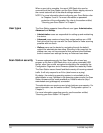
A-61588 July 2008 2-3
Email Server Settings — found under the Settings button in the Configuration Organizer or
Administration GUI.
Parameter Name Description/Sample Your Setting Notes
SMTP Settings
• Server Address
Fully qualified domain name or
IPv4 address of the SMTP server
(e.g., smtp-server.
company.com or 192.0.0.1).
Use IPv4 to eliminate any DNS issues
when troubleshooting.
• Credentials
User name, password and network
domain. Required to access the
SMTP server.
Required for authenticated SMTP.
NOTE: This is not necessarily the
same as the credentials defined
under Device Settings.
•Port
Default: 25 Only change if your email server
communicates on an IP port that is
not Port 25.
• SSL
Secure Socket Layer Typically unchecked. Check only if
you are sure your email server
requires it.
LDAP Settings
• Server Address
Fully qualified domain name or
IPv4 address of the LDAP server
(e.g., ldap-server.
company.com or 192.0.0.1).
Use IPv4 to eliminate any DNS issues
when troubleshooting.
• Credentials
User name, password and network
domain. Required to access the
LDAP server.
Required for authenticated LDAP.
NOTE: This is not necessarily the
same as the credentials defined
under Device Settings.
•Port
Default: 389 Only change if your LDAP server
communicates on an IP port that is
not Port 389.
• Base DN
Base Distinguished Name Contact your corporate LAN
administrator for more details on this
setting.
• Common Name
Tag
Default: cn Contact your corporate LAN
administrator for more details on this
setting.
• Email Address
Tag
Default: email Contact your corporate LAN
administrator for more details on this
setting.
Return Email
Address
This is the address that bounced
emails are returned to (e.g.,
bounce@company.com). This
address will also appear as the
“From” address when sending
email.
Select a person who will receive
notification that an email address
could not be reached.
Maximum
Attachment Size
1-99 MB
Default: 10 MB
Email operations that create files
larger than this will fail. This should
match the limitations defined by
your email server.
Custom Email
Addresses
Enables/disables the custom Email
address option, allowing the entry
of email addresses that do not
appear in your address book.
Typically enabled; may be disabled in
more secure environments.


















